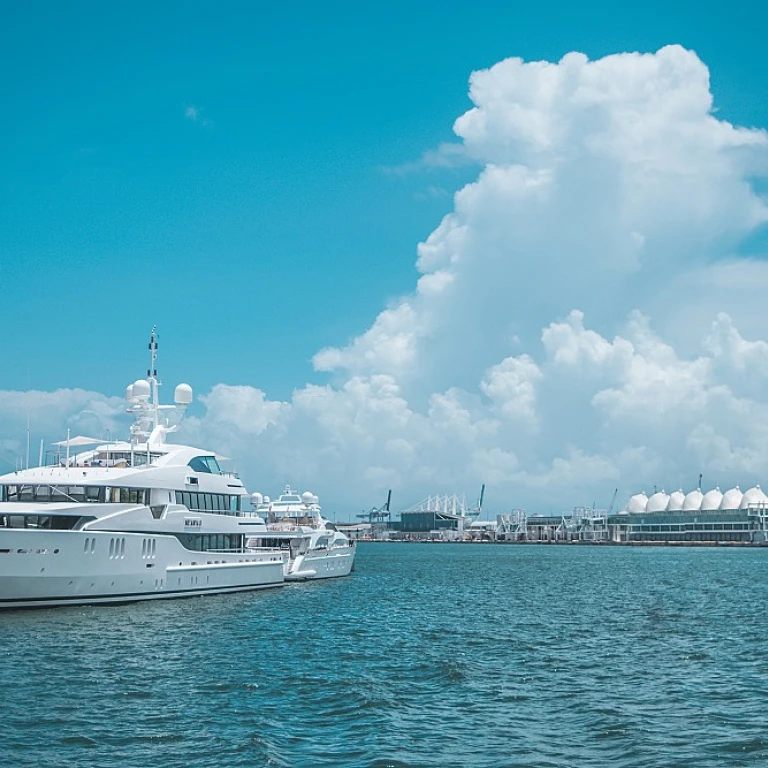The Role of a Boat Drain Plug in Yacht Maintenance
The Vital Component in Yacht Maintenance
Boat drain plugs play an essential role in maintaining the integrity and performance of your yacht. These small but mighty accessories are fundamental for preventing unwanted water accumulation in your vessel. Whether it's brass, stainless steel, or rubber plugs, each product ensures effective water evacuation, keeping your boat in optimal condition.
Understanding the importance of selecting the right plug for your yacht is crucial. Marine plugs, such as the popular garboard drain options, are specifically designed for marine environments, offering durability and reliability. The transom drain plug, for example, provides a secure seal to prevent water ingress while allowing for easy drainage when needed.
When selecting from various options, including brass drain plug or a sturdy stainless steel variant, it's important to consider the location and application. Some yacht enthusiasts might prefer the functionality of a remote drain plug system, offering ease of use with a snap handle or integrated cable.
For those who regularly sail in rugged waters, investing in a high-quality item with a dependable seal is vital to maintaining your boat's hull integrity. It's equally important to review the size and fit of the drain hole to ensure that you have the appropriate plug boat installations. Poor fit or compatibility issues can lead to potential leaks and other water-related problems.
Apart from ensuring your luxury yacht remains safe and dry, a quality boat drain plug system provides the peace of mind you need for all your maritime adventures. For more information on complementary yacht accessories, consider visiting
this resource on fenders for aluminum boats that enhance protection and longevity.
Types of Boat Drain Plugs and Their Applications
Exploring the Various Options for Boat Drain Plugs
When it comes to yacht maintenance, selecting the appropriate drain plug is crucial. Boat drain plugs, often underestimated, play a vital part in preventing water ingress and maintaining the integrity of your vessel. The market offers a variety of options designed to suit specific needs and preferences, each with its own set of benefits and applications.
Brass drain plugs and stainless steel options are popular choices due to their durability. Brass is corrosion-resistant and ideal for freshwater environments, while stainless steel thrives in marine settings with its robust nature against sea elements. Consider the specific location of your drain plug; garboard drains are usually installed on the transom, providing an effective solution for draining water.
For a simpler approach, rubber plugs and snap handle designs offer user-friendly installation and replacement methods. These types of plugs are excellent for temporary use or for those looking for a quick fix. They often come in plug kits, including necessary accessories for easy installation.
With advancements, remote drain and flow rite systems offer enhanced convenience, allowing operators to open and close the drain from a distance, thus avoiding manual operation in difficult circumstances. It's essential to match the drain plug type to the particular requirements of your boat for optimal efficiency.
To provide a deeper understanding of the importance and intricacies of choosing the right drain plug, refer to this
guide on cutlass bearings in yacht maintenance. This guide offers insights into how different components come together to maintain your yacht's optimal performance, including choosing the right materials and systems for long-term benefits.
Weighing the price of these drain solutions against their benefits is significant; options like brass, stainless steel, and other marine-centric products often come with the promise of free shipping and detailed plug reviews online, providing value for money. Whether you favor a plug that fits your specific yacht needs or you're interested in the latest innovations, a well-informed choice will lead to a more secure and reliable marine experience.
Installation and Replacement Tips for Boat Drain Plugs
Proper Installation and Effective Replacement of Drain Plugs
The effectiveness of a boat drain plug in ensuring your yacht remains free of unwanted water largely depends on its correct installation and timely replacement. Whether you're dealing with a garboard drain or a more advanced remote drain system, ensuring a proper fit and secure placement is paramount.
For those opting for brass drain plugs, ensure that the plug fits snugly into the designated drain hole. Brass is favored due to its durability and resistance to corrosion, making it suitable for marine environments. Stainless steel and rubber plugs are also popular choices, providing flexibility and resilience against wear and tear.
During installation, it's crucial to determine the exact location where the plug marine accessories will be inserted. This often falls at the lowest point of the transom drain to facilitate effective drainage. Consider using a snap handle or flow rite system for ease of use, especially when access to the plug's location is challenging.
Replacement, on the other hand, demands attention to detail. If you're noticing wear or damage, it might be time to replace your boat drain plug. Regular maintenance checks should include cable inspections to ensure all components are intact. Products like a plug kit or remote drain system can simplify this process, as they come equipped with all necessary items for a straightforward installation.
Don't forget to review the plug reviews and prices to choose a product that suits your needs and budget. Opting for marine-grade stainless steel or brass options often provides additional peace of mind.
For those concerned about the hassle of deactivating and reactivating drain plugs, understanding the nuances of installation techniques is essential. Mastering such skills can make all the difference in maintaining a safe and efficient drain system on your yacht. For additional insights, check out this article on
using a sand anchor for yachts, which provides valuable guidance on other essential yachting skills.
Common Issues with Boat Drain Plugs and How to Solve Them
Resolving Common Drain Plug Issues Efficiently
Navigating common issues with boat drain plugs is an integral aspect of maintaining your yacht. When faced with these challenges, it's essential to understand both their underlying causes and effective solutions to ensure your boat remains seaworthy and free of avoidable mishaps.
- Leaking Drain Plugs: Leaks can often be traced back to deteriorated seals or improper installation. To remedy this, inspect the rubber washers or O-rings for wear and replace them if necessary. Ensuring a snug fit during installation is crucial. A misplaced or warped marine drain plug can lead to unnecessary water ingress.
- Rust and Corrosion: Brass and stainless steel are popular materials for drain plugs due to their resistance to corrosion. However, marine environments can still pose challenges. Regularly check your brass and stainless steel items for signs of corrosion and consider using corrosion-resistant coatings to prolong their lifespan.
- Stuck or Seized Plugs: Sometimes, a drain plug might resist removal due to sediment or debris causing sticking in the hole. Avoid forcing it, which could damage the threads. Instead, apply a penetrating oil like a product specifically designed for marine conditions to loosen the plug gently.
- Lost or Misplaced Plugs: It’s not uncommon to misplace small accessories like plugs. To mitigate this, investing in a plug kit that stays attached with a cable to the boat can prevent loss, ensuring that the plug remains in the right location at all times.
Ensuring the reliability of your yacht's drain system is not simply about resolving existing issues. Regular maintenance and inspecting your drain plugs after each voyage can prevent problems before they arise, saving time and costly repairs. By recognizing and addressing these common issues promptly, you'll enhance not just the functionality but also the safety of your marine adventures.
Innovations in Boat Drain Plug Technology
Innovative Approaches in Modern Boat Drain Plug Technology
The world of boat drain plugs is continuously evolving, with new innovations making yacht maintenance not only more effective but also easier and safer. As technology advances, manufacturers are developing products that meet the diverse needs of those who are passionate about yachts. One such advancement includes the increased use of stainless steel in the construction of drain plugs. This material offers greater resistance to corrosion and wear compared to traditional options like brass.
Moreover, the introduction of remote drain systems is revolutionizing the way yachts are maintained. These systems allow boat owners to manage the drainage process with enhanced ease, avoiding the necessity of physically reaching the transom drain location. This innovation is particularly beneficial for larger models like Sea Ray yachts, where accessibility can be challenging.
Another trend is the incorporation of snap handle designs in drain plugs. Products such as those from the Flow-Rite series provide a user-friendly approach, enabling quick and efficient plug management without requiring specialized tools.
Additionally, recent developments in plug kits offer more comprehensive solutions by including all necessary accessories for installation and maintenance, ensuring the plug fits perfectly into the designated hole. This approach not only saves time but also reduces the likelihood of water leaks caused by improper fittings of rubber plugs or other materials. It's crucial for boat owners to stay informed about these innovations, as the right choice of a boat drain product can significantly enhance the overall marine experience.
While exploring these advanced options, it’s important to weigh the price against the benefits provided, ensuring that free shipping and reliable plug reviews guide your decision-making process. As the marine industry continues to enhance its offerings, adopting modern drain plug solutions ensures you're prepared for seamless boating operations, safeguarding your investment against the elements.
Safety Considerations When Using Boat Drain Plugs
Prioritizing Safety with Your Boat's Drain Plug
Ensuring safety while managing your boat's drain plug is essential for all boat owners. The primary concern when dealing with drain plugs is the potential for water ingress into areas where it shouldn't be, which can lead to significant damage. To mitigate this risk, here are some safety considerations:
- Material Matters: Choosing the right material for your drain plug is crucial. Marine-grade materials like stainless steel or brass are recommended due to their resistance to corrosion in marine environments. For instance, a stainless steel or brass drain significantly reduces the risk of rust, thereby lowering maintenance requirements.
- Regular Inspection: Frequent inspections of your boat's drain plug and its gasket are vital. Over time, wear and tear from water pressure or debris can lead to a compromised seal. This can easily be avoided by routine checks and timely replacements if any wear is noticed.
- Secure Installation: Ensure the drain plug is securely installed to prevent accidental loosening, especially in high-motion scenarios. Properly fitted plugs and accessories reduce the chances of unexpected water ingress and potential damage. Secure fixtures like a snap handle or a garboard drain setup can provide peace of mind while cruising.
- Consider Remote Drain Systems: Implementing remote drain systems with cable pulls can enhance safety by allowing the drain to be accessed from within the boat. This reduces the need to reach difficult or risky positions when checking or operating the plug.
- Prompt Maintenance: In case of any indication of issues such as leaks or difficulty in removing the plug, it’s important to address these problems immediately. Ignoring early signs can lead to more significant complications, potentially leading to expensive repairs.
Keeping your vessel's safety in mind when dealing with your boat's drain plug encompasses understanding the various types of plugs available, installations tips, and maintaining vigilance with regular checks. By doing so, you not only prolong the life of your drain system but also ensure that your boating experience remains safe and enjoyable.

